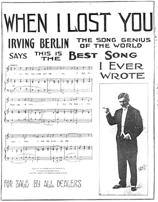What did Sheet Music Look Like
Dominic Vautier
8/7/2011
Sheet
music came in two sizes; the old style song sheet measured a little more
than 11
inches wide and 14 inches high. The smaller size sheet introduced
later was close too 9 by 12
inches. Most pieces were printed
in the larger size until about 1910, when the piano music holders
began
to get smaller and publishers wanted to save paper and transportation
costs. The 9 by 12 size
started appearing about that time and became the standard after the
First World War, but a few of the larger sized sheets can be found as late as
1920.
 Some
music came in books of songs, marches, or waltzes, but most of the time
each piece contained one song and was usually made up of one double
folded sheet with a single sheet inside, making a total of three pages
or six sides. Since one side
was for the cover and the other for advertisement, four sides were left
for the music. The
songwriters had to consider these things when they published.
Songs had to be written and arranged in a way that
accommodated four printed pages. I have sheets that have one and
two inserts. Some are bound with a staple, but more often nothing.
Some
music came in books of songs, marches, or waltzes, but most of the time
each piece contained one song and was usually made up of one double
folded sheet with a single sheet inside, making a total of three pages
or six sides. Since one side
was for the cover and the other for advertisement, four sides were left
for the music. The
songwriters had to consider these things when they published.
Songs had to be written and arranged in a way that
accommodated four printed pages. I have sheets that have one and
two inserts. Some are bound with a staple, but more often nothing.

The
advertisement was usually a full page on the inside front cover and/or on
the back side, and it frequently showed samples of other songs available through
that publisher.
After
1900 I notice the front cover was often done in color, and some covers are very
artistic. However, more
often there was just a title and the picture of a singer or famous song
plugger who popularized the song. This
practice was carried forward into the recording industry, when singing
stars became the main advertisers for a song and appeared on the
record jacket. The back of
record jackets or record sleeve advertised other songs by the same publisher, a
continuation of sales practices used in sheet music.
Most
of the time, we know who wrote the music but we donít know too much
about who was responsible for the sometimes excellent artwork on the
song cover page. Each
publishing house could employ one or more artists to design the sheet
covers, but they didnít keep good records. Even up until 1900 most of the artists who designed the
sheet-music covers remained unknown.
Included also on the cover is the publishing
house. All publishing houses
had their own logo. Sometimes
there was a picture of the songwriter or lyricist or, more frequently,
the publisher. The copyright
date appears on the inside cover on the first page often in Roman
numerals..
publishing
house. All publishing houses
had their own logo. Sometimes
there was a picture of the songwriter or lyricist or, more frequently,
the publisher. The copyright
date appears on the inside cover on the first page often in Roman
numerals..

Song
sheets usually had no list price. The
price for a piece of sheet music could be 25 to 50 cents, although it
was totally negotiable. There were price wars,
and the cost could got down to 5 cents a sheet.
Publishers printed sheet music for as little as 2 cents a copy, so
even at this low bargain price, lots of opportunity for profit remained.
Return
to home page
 Some
music came in books of songs, marches, or waltzes, but most of the time
each piece contained one song and was usually made up of one double
folded sheet with a single sheet inside, making a total of three pages
or six sides. Since one side
was for the cover and the other for advertisement, four sides were left
for the music. The
songwriters had to consider these things when they published.
Songs had to be written and arranged in a way that
accommodated four printed pages. I have sheets that have one and
two inserts. Some are bound with a staple, but more often nothing.
Some
music came in books of songs, marches, or waltzes, but most of the time
each piece contained one song and was usually made up of one double
folded sheet with a single sheet inside, making a total of three pages
or six sides. Since one side
was for the cover and the other for advertisement, four sides were left
for the music. The
songwriters had to consider these things when they published.
Songs had to be written and arranged in a way that
accommodated four printed pages. I have sheets that have one and
two inserts. Some are bound with a staple, but more often nothing. 